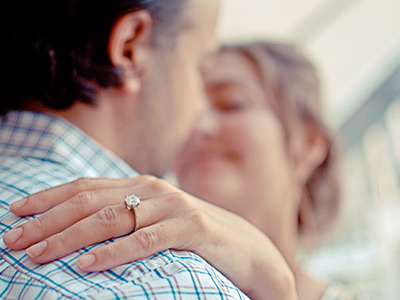 Ah, the engagement ring, that symbolic piece of sparkly jewelry on the fourth finger of a woman’s left hand that proclaims to the world, “I’ve found the one I love and intend to marry.” If you just received yours, it was probably the happiest day of your life so far. But did you know that the giving and receiving of a ring to symbolize a couple’s commitment to each other dates back to antiquity?
Ah, the engagement ring, that symbolic piece of sparkly jewelry on the fourth finger of a woman’s left hand that proclaims to the world, “I’ve found the one I love and intend to marry.” If you just received yours, it was probably the happiest day of your life so far. But did you know that the giving and receiving of a ring to symbolize a couple’s commitment to each other dates back to antiquity?
It does, and we can thank the ancient Egyptians for starting this custom. No such things as engagements or weddings existed back then, but in the Egyptian belief system, the circle was seen as the perfect symbol of forever since a circle has no beginning and no end. Therefore a circular ring symbolized if not endless love, at least endless affection and/or commitment between a man and a woman. Consequently, a couple gave each other rings, usually made out of braided reeds or hemp. One can only wonder how many times these rings had to be replaced over the years as the grasses aged and deteriorated. And why were they worn on the left hand’s fourth finger? Because the Egyptians believed that a special vein in that finger went straight to the heart.
Ancient Roman Marriage Customs
By the time of the ancient Romans, paternalism was in full sway. Women were seen as property, belonging first to their fathers and then to their husbands. Not surprisingly, marriages were business contracts between the fathers of two families, complete with a legally binding written contract, a dowry for the man; i.e., property or money brought by a bride to her husband on their marriage, and a ring for the woman. Generally, it was made out of iron, but if the man was one of high status, it could be made out of gold and embellished with carvings or inscriptions to attest to the man’s wealth and position. Either way, the ring proclaimed the woman as her husband’s possession.
Thou Shalt Remain Faithful
During the Renaissance, roughly 1300–1600, puzzle engagement/wedding rings were all the rage. One version, called the gimmel ring, had two pieces, one worn by the woman and one by the man during their engagement. Another version had three pieces, the third being worn by a second man who would serve as the witness to the marriage. On the wedding day, the pieces were interlocked, forming one design, and placed on the bride’s ring finger. These puzzle rings, however, served a darker purpose. The idea was to make the puzzle so intricate that should the married woman remove her ring, she’d never get it put back on correctly and her husband would know she’d been unfaithful to him. Apparently it never occurred to the men that if their wives wanted to be unfaithful, they didn’t need to take their rings off in order to do so.
True Engagement Rings
By the time of England’s Queen Victoria, 1837–1901, engagement rings had come into their own as the first of two rings given by a man to a woman, the second being the wedding ring itself. Given the rather opulent and “busy” styles of the day, most Victorian engagement rings had intricate filigrees, hearts, flowers, and other embellishments.
Diamonds had already become popular engagement ring stones, but gemstones were often used instead of or in addition to diamonds. In fact, the engagement ring that Prince Albert gave Queen Victoria was a gold serpent ring complete with an emerald serpent’s head. Needless to say, serpent rings became the new trend.
Other Victorian contributions to the engagement ring included rings made out of silver instead of gold, a trend that continued until the early 1900s. And the iconic diamond solitaire came into existence when Tiffany & Co. introduced it in 1886, set in a platinum band.
Continuing Evolution
Despite Tiffany’s best efforts, the popularity of diamond engagement rings took a decided downturn during the 1930s and 1940s. For one thing, few people could afford diamonds during the Great Depression and World War II. Rings of this era were far more likely to contain gemstones. If diamonds, they likely were older ones or ones repurposed from other jewelry pieces.
It took the De Beers diamond company to bring back the diamond’s popularity. After the enormous diamond finds made in its African mines, the company launched its worldwide “a diamond is forever” ad campaign in the 1950s. Consumers came in droves, and today, diamonds still account for 74% of the engagement ring market.
Add Your Comment